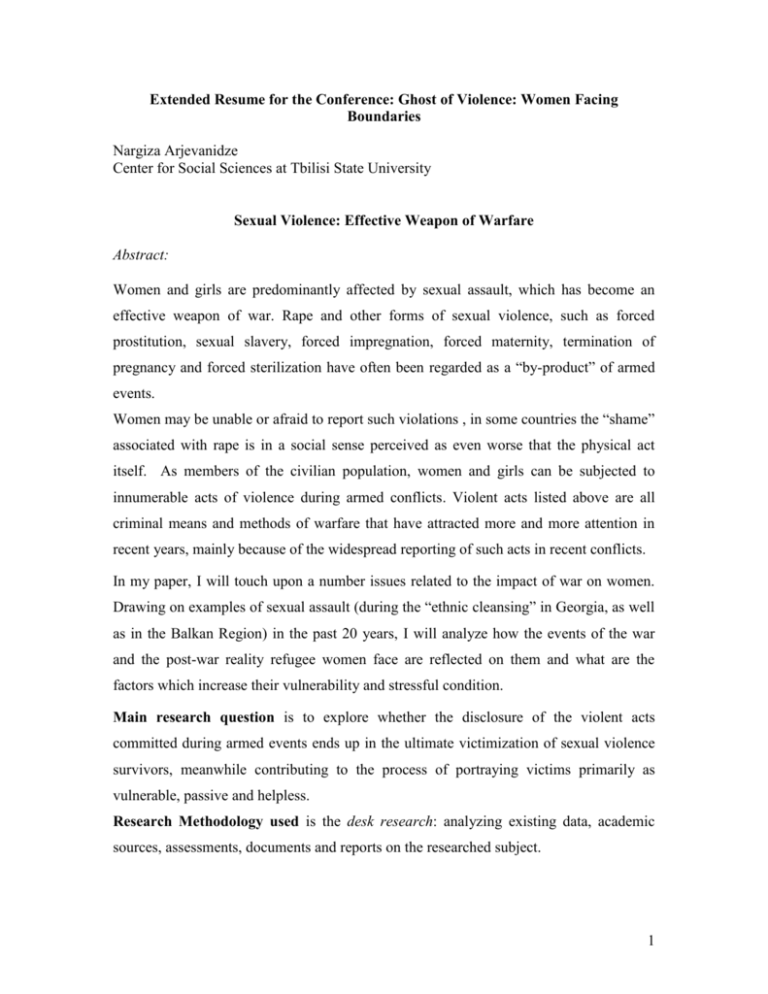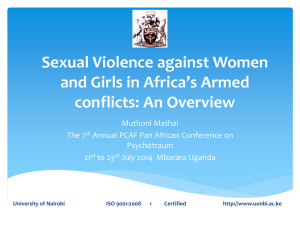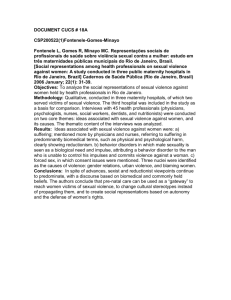
Extended Resume for the Conference: Ghost of Violence: Women Facing
Boundaries
Nargiza Arjevanidze
Center for Social Sciences at Tbilisi State University
Sexual Violence: Effective Weapon of Warfare
Abstract:
Women and girls are predominantly affected by sexual assault, which has become an
effective weapon of war. Rape and other forms of sexual violence, such as forced
prostitution, sexual slavery, forced impregnation, forced maternity, termination of
pregnancy and forced sterilization have often been regarded as a “by-product” of armed
events.
Women may be unable or afraid to report such violations , in some countries the “shame”
associated with rape is in a social sense perceived as even worse that the physical act
itself. As members of the civilian population, women and girls can be subjected to
innumerable acts of violence during armed conflicts. Violent acts listed above are all
criminal means and methods of warfare that have attracted more and more attention in
recent years, mainly because of the widespread reporting of such acts in recent conflicts.
In my paper, I will touch upon a number issues related to the impact of war on women.
Drawing on examples of sexual assault (during the “ethnic cleansing” in Georgia, as well
as in the Balkan Region) in the past 20 years, I will analyze how the events of the war
and the post-war reality refugee women face are reflected on them and what are the
factors which increase their vulnerability and stressful condition.
Main research question is to explore whether the disclosure of the violent acts
committed during armed events ends up in the ultimate victimization of sexual violence
survivors, meanwhile contributing to the process of portraying victims primarily as
vulnerable, passive and helpless.
Research Methodology used is the desk research: analyzing existing data, academic
sources, assessments, documents and reports on the researched subject.
1
For the purpose of this paper the UN Declaration on the Elimination of Violence against
Women defines the “violence against women"1 as:
“Any act of gender-based violence that results in, or is likely to result in, physical,
sexual or psychological harm or suffering to women, including threats of such acts,
coercion or arbitrary deprivation of liberty, whether occurring in public or in private
life.”
Over the last two decades, the international community has recognized that women and girls
are often primary targets of sexual abuse because of their gender, which previously used to be
neglected and perceived as a normal, usually inevitable consequence of armed events during
which sexual abuse historically has been used an effective tool. ‘Although rape as a weapon
of war violates the Geneva Conventions and was specifically identified as a war crime by the
Rome Statute establishing the International Criminal Court, rape continues in many
conflicts.’ (Amnesty International, 2008).
Biological difference may not always serve as the basis for women’s problems according
to Charlotte Lindsey, who notes that a woman ‘may also be raped because the
perpetrator’s aims to make her pregnant so as to produce children having the
perpetrator’s patrilineage, and/or because social, cultural or military education has not
taught the perpetrator that women should be protected and that rape is prohibited.’
(Lindsey, p.3)
Gender-based violence is a general term that entails different types of gender-specific
violence, including the sexual assault. Although, the concept of gender-based violence was
gradually reduced to sexual violence after rape became an imperative issue for feminists,
especially after the first accounts of mass rapes (in the former Yougoslavia) became public due
to the Geo-political situation of the late 1980s and early 1990s, which triggered shifts in
feminist studies of war.
Sexual assault in the Balkans was considered as most appalling in the human history. Feminist
theoretical reflections of Yoguslav and the Rwandan wars largely concentrated on war rapes. As
pointed out by Dubrovla Zarkov ‘more importantly, classical feminist studies of women and
1
General Assembly resolution 48/104 of 20 December 1993
http://www.unhchr.ch/huridocda/huridoca.nsf/(symbol)/a.res.48.104.en
2
war shifted from a conceptualization of agency and empowerment to theoretically and
politically much more problematic conceptualization of sexual victimization‘.(Zarkov
p.218)
While comparing abovementioned two conflicts Zarkov elaborates on considerable visibility of
sexual violence in the Balkan region as compared with the rapes taking place in Rwandan
conflict:
“Its symbolic inclusion into Europe made rapes there more visible and more relevant
for Western feminist theorizing on war rapes, compared with, for example, rapes
during the Rwandan Civil War. The violence in Rwanda remained for a long-time
quite invisible theoretically in Western feminism, although it mobilized women's
organizations and feminist NGOs across the globe. The wars in Yugoslavia, in
contrast, caused an enormous academic production in a wide range of disciplines.
[…]” (p.118)
Sexual violence in fact has predominantly been used against women and girls - and to a
lesser extent against men and boys - as a form of torture used to degrade, intimidate and
ultimately defeat and chase away targeted populations:
“The holding up of women as symbolic bearers of caste, ethnic or national identity
can expose them to the risk of attack.The wide-spread occurrence of rape in times
of conflict has attracted particular attention and has been seen as directly related to
the position of women in communities as bearers of cultural identity in
communities. The rape of women in conflict situations is intended not only as
violence against women, but as an act of aggression against a nation or
community.” (Byrne,B.p.16)
Reinhild Traitler-Espiritu in “Violence against women’s bodies” links the idea that abusing a
woman bears the meaning of humiliating the whole community to the ‘notion of women as
property of men, to male control over women’s sexuality,’ insofar as ‘violence against women’s
bodies is almost always violence against women’s sexuality.’ (Traitler-Espiritu p.70)
Thus, in the above pattern, we have a clear hierarchy of power relations: the dominance of the
physically violent male (subject) over the weak and subjugated female (object), as a result of
which sexually abused women are perceived as vulnerable, weak and unprotected.
Survivors of sexual violence are even more vulnerable when they are exposed to public; that’s
how visibility goes hand in hand with yet another victimization of raped women as described by
Zarkov with regard to the former Yugoslavia context:
“Testimonies of raped women turned into legal narratives that benefited either
prosecution or the defense, but hardly women themselves insofar as the
testifying woman was reduced to a dismembered and passive victim. Thus […]
3
the public testifying at the court is turned into an act that reproduces the
woman’s victimization.” (p.220)
There are cultures where visibility of the rape as a weapon of war is still associated with
shame and disgrace, which can be considered as a primary reason of the very limited data
and reports on the acts of sexual violence occurring in the situations of armed conflicts;
Social and cultural norms affect the visibility of the victim of sexual violence.
While there might be an abundance of stories on survivor narratives by women sexually
assaulted during the armed events, they never reach the public; Because of the cultural
norms prevalent and rooted in that community victims choose to be silent and never speak
out their traumatic past events. Due to the fact that the sexual assault is a taboo issue and stigma is
associated with rape in the Georgian cultural context,
case of Georgia might to a certain extent fit
into this paradigm.
Very scarce official data exists on the cases of gender-based violence during the armed
events in Abkhazia in the beginning of 1990s. ICRC country report Georgia/Abkhazia on
the rules of war published in 1999 notes, that:
“Nearly one-fifth of Abkhaz respondents (19 percent) say they were imprisoned and a
significant minority (8 per cent) were either tortured or wounded. And many say someone
they knew well was raped (8 per cent) or sexually assaulted (7 per cent). By contrast,
only 2 per cent of Georgian respondents report similar experiences. (p.2)”
In contrast to the above report, more than a decade later after 2008 August events in
Tskhinvali region, Institute for Policy Studies conducted and published “Rapid needs
assessment of internally displaced women residing in collective centres in Georgia”.
(2008) The authors note that they gathered ‘significant amount of extremely brutal, as well
as heartbreaking stories’ according to which:
“Among the alleged victims of torture, women comprised 18.3 percent, and 1.6 percent
of the respondents reported witnessing torture. More men (10.2 percent and 16 percent)
than women (4.7 percent and 7.9 percent) experienced physical and verbal abuse.[…]
The age of abused women and girls varied from 12 to 77, with 25-35 age group
mentioned most frequently. “(p.8)
4
Authors of the Assessment assume that ‘due to stigma attached to sexual abuse it is likely that in
general many women simply do not admit that they have been exposed to any physical or verbal
abuse’.
In relation to the aforementioned two conflicts, it has to be mentioned that in March, 2010, the
Human Rights Priority and the Caucasian Women’s Network filed a strategic litigation to
the ECHR on the case of sexual abuse against a Georgian woman during the August war:
“This only case of sexual violence since the war in Abkhazia and the August
war that has been sent to the ECHR. There were lots of cases during
Abkhazian war that time and now as well, but none of the victims agreed to
appeal. This woman is an exception”- says Lia Mukhashavria, the head of
the Human Rights Priority.2
Most of the victimized individuals do not agree to speak about sexual violence. The
above fact might be seen as a breakthrough which will encourage other victimized
women to defend their rights.
Impact of Sexual Assault:
As regards the effects of the sexual violence and the post-war reality for raped
individuals, it might depend on the degree of physical and physiological damage during
the violent act itself.
There are cases when victims may be raped multiple times or gang raped, which can
cause a much higher degree of physical and physiological injuries, and often lead to
death. The long-term physical effects of rape can include pregnancy and sexual
transmitted diseases including HIV/AIDS. Rapes may be carried out with different
objects to impose additional pain on the victim. ‘The violent nature of rapes increases the
long-term and permanent physical damages for survivors.[…] Studies showed an increase
of suicide as the long-term systematic effects, especially among women of child-bearing
years which may be related to unwanted pregnancies due to rape.’(Clifford, p.3)
Victims may also suffer from the so-called Posttraumatic Stress Disorder or PTSD
syndrome. PTSD can occur following the experience or witnessing of life-threatening
events such as military combat, natural disasters, terrorist incidents, serious accidents,
2
http://humanrightshouse.org/Articles/13648.html
5
and violent personal assaults like rape or physical violence. Some survivors of trauma
have stress reactions that get worse over time. These individuals may develop
Posttraumatic Stress. People who suffer from this condition often remember the
experience through nightmares, flashbacks, emotional numbing, depression, guilt,
autonomic arousal, explosive violence, difficulties in sleeping, feeling of alienation and
other symptoms characteristic to PTSD. (Ruth Leys p.5).
It has to be noted that females are not the not the only victims of sexual violence. Men as
victims of gender-based violence in armed conflicts have recently received attention.
Men have been known to be directly raped, humiliated and demoralized by taking away
their perceived manhood and masculinity. ‘In Croatia it is estimated that some 4,000
males were sexually assaulted. (Clifford p.5)
Zarkov highlights the importance of bringing in the subject of male victims of sexual
violence for feminist studies of war because violable sexuality of women has almost
become a dominant framework of feminist analysis of sexual violence against women in
war:
“The research on sexual victimization of men in violent conflict, while still in
its inception, is important for feminist studies of war precisely because it
cautions us to avoid fatal linkages between femininity and victimization. “
(Zarkov p.223)
Concluding the paper I would also like to emphasize the need for more research on the
men as victims of gender-based violence during armed conflicts, as well as the need to
eradicate double victimization of raped individuals by exposing their stories to the public
not in the right way. Certain alternative means of justice should be employed which will
not lead the victims to the condition of vulnerability.
There should be consolidated efforts from the civil society, government and each
individual to build up an egalitarian environment that will not leave the space for gender
inequalities, and in which, because of the cultural stereotypes, stigma will not be
associated with rape.
6
Violent acts leave the victims with long-lasting wounds and traumas which might never
heal. Insofar as impunity contributes to the perception that sexual assault is an
unavoidable outcome of warfare, it is essential that war crimes including gender-specific
violence during armed events be persecuted, which may ultimately end the use of sexual
assault as an effective weapon of war.
References:
Dubravka Zarkov: ‘Towards a new theorizing of women, gender and war’, in Evans M,
Davis K, and Lorber, J. (eds) Handbook of Gender and Women’s Studies, SAGE, 2006
BYRNE, B., Gender, Conflict and Development, BRIDGE Briefings on Development and
Gender, Ministry of Foreign Affairs, Netherlands, 1996, p.16 in Women Facing War ;
Charlotte Lindsey, p.52
Ruth Leys: Trauma: a genealogy; University of Chicago.2000
Reinhild Traitler-Espiritu : Violence against Women’s Bodies in Women Resisting Violence:
Spirituality for Like. Edited by: Mary Hohn Mananzan (Et al.) 2004
Cassandra Clifford: Rape as a Weapon of War and it’s Long-term Effects on Victims and
Society, 7th Global Conference Violence and the Contexts of Hostility;2008
UN Declaration on the Elimination of Violence against Women
General Assembly resolution 48/104 of 20 December 1993
http://www.unhchr.ch/huridocda/huridoca.nsf/(symbol)/a.res.48.104.en
Amnesty International: Rape as a Weapon of War: Sexual Violence in Armed Conflict
Testimony Submitted to the Senate Judiciary Committee, Subcommittee on Human
Rights and the Rule of Law Alexandra Arriaga Amnesty International USA April 1,
2008. Revised version April 8, 2008
http://www.amnestyusa.org/women/svaw/pdf/IVAWA_Apr08Senate_testimony.pdf
Charlotte Lindsey
Women facing War: ICRC study on the impact of armed conflict on women.2001
7
Rapid needs assessment of internally displaced women residing in collective centres
in Georgia; Institute for Policy Studies, October 2008, Tbilisi
http://www.ungeorgia.ge/userfiles/files/IDW%20Needs%20Assessment%20ENG.pdf
People on War Report: ICRC worldwide consultation on the rules of war. Country
report Georgia/Abkhazia; Report by Greenberg Research, Inc. 1999
http://www.icrc.org/eng/assets/files/other/georgia.pdf
8










